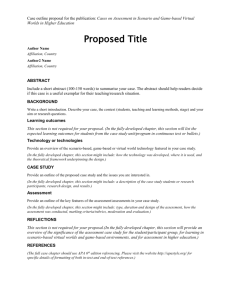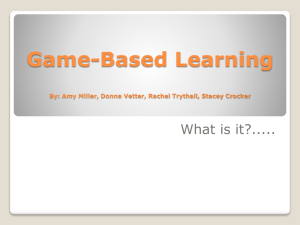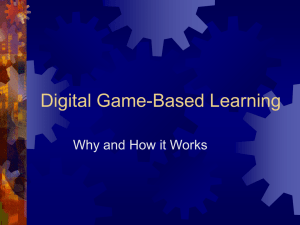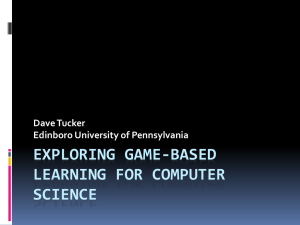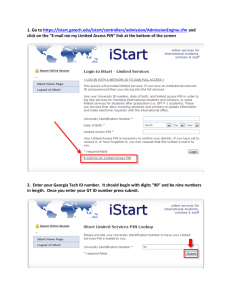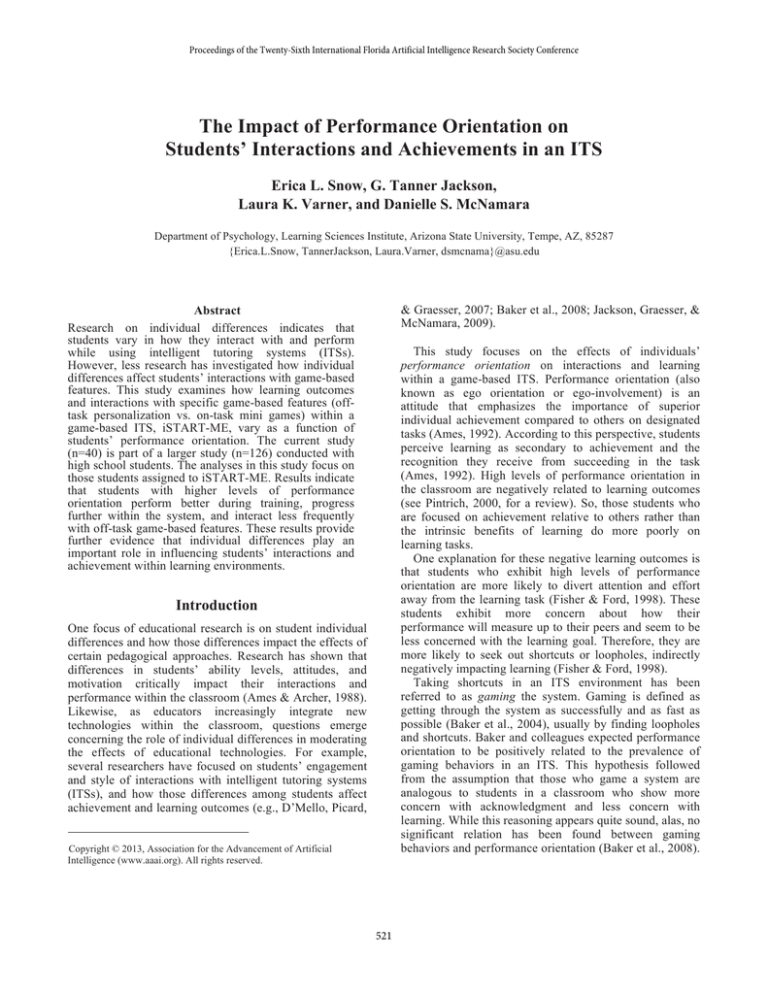
Proceedings of the Twenty-Sixth International Florida Artificial Intelligence Research Society Conference
The Impact of Performance Orientation on
Students’ Interactions and Achievements in an ITS
Erica L. Snow, G. Tanner Jackson,
Laura K. Varner, and Danielle S. McNamara
Department of Psychology, Learning Sciences Institute, Arizona State University, Tempe, AZ, 85287
{Erica.L.Snow, TannerJackson, Laura.Varner, dsmcnama}@asu.edu
& Graesser, 2007; Baker et al., 2008; Jackson, Graesser, &
McNamara, 2009).
Abstract
Research on individual differences indicates that
students vary in how they interact with and perform
while using intelligent tutoring systems (ITSs).
However, less research has investigated how individual
differences affect students’ interactions with game-based
features. This study examines how learning outcomes
and interactions with specific game-based features (offtask personalization vs. on-task mini games) within a
game-based ITS, iSTART-ME, vary as a function of
students’ performance orientation. The current study
(n=40) is part of a larger study (n=126) conducted with
high school students. The analyses in this study focus on
those students assigned to iSTART-ME. Results indicate
that students with higher levels of performance
orientation perform better during training, progress
further within the system, and interact less frequently
with off-task game-based features. These results provide
further evidence that individual differences play an
important role in influencing students’ interactions and
achievement within learning environments.
This study focuses on the effects of individuals’
performance orientation on interactions and learning
within a game-based ITS. Performance orientation (also
known as ego orientation or ego-involvement) is an
attitude that emphasizes the importance of superior
individual achievement compared to others on designated
tasks (Ames, 1992). According to this perspective, students
perceive learning as secondary to achievement and the
recognition they receive from succeeding in the task
(Ames, 1992). High levels of performance orientation in
the classroom are negatively related to learning outcomes
(see Pintrich, 2000, for a review). So, those students who
are focused on achievement relative to others rather than
the intrinsic benefits of learning do more poorly on
learning tasks.
One explanation for these negative learning outcomes is
that students who exhibit high levels of performance
orientation are more likely to divert attention and effort
away from the learning task (Fisher & Ford, 1998). These
students exhibit more concern about how their
performance will measure up to their peers and seem to be
less concerned with the learning goal. Therefore, they are
more likely to seek out shortcuts or loopholes, indirectly
negatively impacting learning (Fisher & Ford, 1998).
Taking shortcuts in an ITS environment has been
referred to as gaming the system. Gaming is defined as
getting through the system as successfully and as fast as
possible (Baker et al., 2004), usually by finding loopholes
and shortcuts. Baker and colleagues expected performance
orientation to be positively related to the prevalence of
gaming behaviors in an ITS. This hypothesis followed
from the assumption that those who game a system are
analogous to students in a classroom who show more
concern with acknowledgment and less concern with
learning. While this reasoning appears quite sound, alas, no
significant relation has been found between gaming
behaviors and performance orientation (Baker et al., 2008).
Introduction
One focus of educational research is on student individual
differences and how those differences impact the effects of
certain pedagogical approaches. Research has shown that
differences in students’ ability levels, attitudes, and
motivation critically impact their interactions and
performance within the classroom (Ames & Archer, 1988).
Likewise, as educators increasingly integrate new
technologies within the classroom, questions emerge
concerning the role of individual differences in moderating
the effects of educational technologies. For example,
several researchers have focused on students’ engagement
and style of interactions with intelligent tutoring systems
(ITSs), and how those differences among students affect
achievement and learning outcomes (e.g., D’Mello, Picard,
Copyright © 2013, Association for the Advancement of Artificial
Intelligence (www.aaai.org). All rights reserved.
521
Hence, the hypothesis that performance orientation is
related to gaming the system has not held up.
In the current study, we explore an alternative
hypothesis. We propose that performance orientation is
related to achievement and interactions in educational
technologies, but not in the way expected by Baker and
colleagues (2004, 2008). While students with high levels of
performance orientation may not game the system per se,
they may still interact with it differently than those with
lower levels of performance orientation. For instance, if
high performance oriented students are focused on
outshining others, they may also focus their efforts on
system features that promote incentives or rewards. This
expectation is particularly relevant to game-based ITSs.
Game-based features have been shown to increase
student engagement and enjoyment within learning
environments (Rai & Beck, 2012; Rai, Beck, & Heffernan,
2010; Jackson & McNamara, 2011, 2012). Hence, there is
an increased interest in incorporating game-based features
into ITSs to enhance student engagement, particularly
during extended training sessions (Cordova & Lepper,
1996; McNamara, Jackson, & Graesser, 2009). However,
while game-based features may enhance engagement, they
may also act as seductive distracters (Rai, Beck, &
Heffernan, 2010). Seductive distracters have the
unfortunate consequence of pulling students’ attention
away from the learning tasks and consequently decreasing
performance (Harp & Mayer, 1998).
Whether game-based features increase engagement or
distract from learning may depend on the type of feature.
Game-based features can be tangential to learning (offtask; e.g., avatar personalization or navigational choices) or
an extension of the learning task (on-task; e.g., extended
practice mini-games or practice quests). These features can
also vary in the amount of incentives they provide based on
student achievement within the system. Although research
has investigated the impact of game-based features on
enjoyment and learning, very little work has investigated
why students choose to interact with specific types of
features versus others. Understanding the influence of
individual differences on system interactions is crucial for
building adaptive systems that promote learning.
In the current study, we investigate the relations between
individual differences in performance orientation and
system interactions, system achievements, and learning
gains. Using the iSTART-ME system, we examine how
students’ interactions with personalizable features (i.e.,
editable avatars, changeable background themes, and
changeable pedagogical agents) and mini-games vary as a
function of self-reported levels of performance orientation.
In the context of iSTART-ME, we expected that high
performance oriented students would be more likely to
interact with features that provide incentives (e.g., trophies,
currency, badges). In turn, by doing so, they would also be
more likely to veer away from game-based features that do
not overtly promote a measure of success.
iSTART
Interactive Strategy Training for Active Reading and
Thinking (iSTART) is an ITS that was designed to
improve students’ comprehension of science texts through
the instruction of reading strategies (McNamara,
Levenstein, & Boonthum, 2004). This system is divided
into three modules: introduction, demonstration, and
practice. During the introduction module, students interact
with three pedagogical agents who discuss definitions and
show students examples of reading comprehension
strategies. After the introduction module is completed,
students are transitioned into the demonstration module. In
this model students watch as two pedagogical agents apply
the previously introduced reading strategies to texts.
Students are then asked to identify which strategy is being
used by the agents in each text. Finally, the practice
module of iSTART provides students with an opportunity
to apply the strategies they have seen to science texts. In
this module, students are shown two example texts and are
asked to generate self-explanations for target sentences. A
pedagogical agent provides formative feedback on
students’ use of the comprehension strategies. An extended
practice module provides the means for additional practice
over weeks or months.
A computational algorithm within iSTART assesses the
quality of students’ self-explanations and guides the
feedback that they receive from the system. Selfexplanations are assessed on a scale of 0 to 3. A score of
“0” is provided when students’ self-explanations are
composed of irrelevant information or are too short. A
score of “1” is given when self-explanations do not
elaborate upon the provided information in the text. A
score of “2” indicates that students’ self-explanations
incorporate inferences from the text, and a“3” indicates
that the self-explanation incorporates information about the
text at a global level.
iSTART-ME
The practice module and extended practice module within
iSTART enhance students’ ability to self-explain and
comprehend challenging text; however, the repetitive
nature of these modules can cause some students to
disengage (Bell & McNamara, 2007; Jackson &
McNamara,
2012).
iSTART-ME
(Motivationally
Enhanced) expands upon the original iSTART system by
incorporating educational games and adding game-based
features into the interface of the original system (Jackson,
Boonthum, & McNamara, 2009). This system incorporates
the three modules from the original iSTART system:
introduction, demonstration, and practice. However, an
added module, called extended practice, was added to
increase students’ engagement and enjoyment. In this
module students interact with a game-based interface that
was designed to reinforce the comprehension strategies.
The iSTART-ME interface is controlled through a
selection menu where students can choose to play games,
522
read new texts, and interact with game-based features (see
Figure 1 for menu screenshot). When students choose to
interact with texts and play games, they earn points within
in the system called iBucks. These iBucks serve as insystem currency and can be used to unlock the game-based
features on the interface.
themes, and interchangeable pedagogical agents. For
instance, students can use their earned iBucks to change
their avatar’s hair colors or clothing (see top left of Figure
1). Each personalization action requires students to spend
300 of the iBucks that they have earned. These features
were designed as off-task incentives and do not contribute
to their earned points or iSTART levels within the system.
Figure 1. Screenshot of iSTART-ME Menu
Figure 2. Screenshot of Balloon Bust
Students can earn iBucks through three different
methods of generative practice: Coached Practice,
Showdown, and Map Conquest. Coached Practice is the
form of generative practice from the original iSTART
system. Showdown and Map Conquest are both gamebased generative practice modules that use the same
assessment algorithm as Coached Practice. All three of
these game-based practice modules require students to
generate self-explanations and practice applying the
strategies (just as they do within Coached Practice).
As students accumulate more iBucks, they advance to
higher levels, where new features are unlocked. Levels
range from 0 (starting level for all students) to 25 (the
maximum level that students can achieve). Each level
requires more iBucks than the previous in order to advance
to a new level. This ensures that students must exert more
effort as they progress through higher levels within the
system. Students can use their earned iBucks to interact
with different game-based features within the ITS
interface. There are two primary types of game-based
features that students can use points to interact with: minigames and personalizable features.
Mini-games were designed to add game-based practice
for strategies that the student had previously seen within
the iSTART-ME system. For instance, in Balloon Bust
students are presented with a text and then provided a
sample self-explanation. They must decide what strategy
was used to generate each sample self-explanation by
clicking on a balloon that represents each strategy (see
Figure 2). Within mini-games, students can earn points and
advance to higher iSTART levels based on their
performance. Each mini-game play costs students 300 of
their earned iBucks.
Personalizable features were designed to engage
students’ interest by allowing them to personalize and
control their environment as a reward for performing well
within the game-based learning tasks. Personalizable
features include editable avatars, customizable background
Methods
Participants in this study included 40 high school students
from a mid-south urban environment. The sample of
students included in the current work is a subset of 125
students who originally participated as part of a larger
study that compared three conditions: iSTART-ME,
iSTART-original, and no-tutoring control. Our study
focuses solely on the students who were assigned to the
iSTART-ME condition. These students had access to the
full system interface where the game-based features
(personalizable features and mini-games) were available.
All 40 students in the iSTART-ME condition completed
an 11-session experiment that consisted of a pretest, 8
training sessions, a posttest, and a delayed retention test.
During the first session, participants completed a pretest
including a self-report survey that assessed individual
differences in affect, motivation, and attitudes toward
technology and games. During the 8 training sessions, the
iSTART-ME participants took part in the extended practice
portion of the experiment. Each of these sessions lasted a
minimum of 1 hour. At the beginning of each session,
students completed a short questionnaire assessing their
current mood and perception of the system. After this
questionnaire, students were transitioned to the iSTARTME interface, where they were free to interact with the
system as they chose for an hour. During session 10,
students completed a posttest, which included the same
measures administered at pretest. Finally, approximately 1
week after the posttest, each student returned to complete a
retention test, which contained measures similar to the
pretest and posttest (i.e., self-explanation and attitudinal
measures).
Students’ performance orientation rating was measured
at pretest through a self-report survey in which students
523
were asked to rate themselves and their attitudes toward
educational technology. To assess students' performance
orientation, each student indicated the relative importance
of the following statement, "It is important for me to do
better than others within the system." This rating was on a
scale from 1 (it is not important to me) to 6 (it is very
important to me). This was the only measure of
performance orientation in the pretest survey; therefore, the
reliability of the measure could not be calculated.
Students’ reading comprehension ability was assessed
using the Gates-MacGinitie Reading Test (MacGinitie &
MacGinitie, 1989). Self-explanations were scored using the
automated iSTART assessment algorithm (McNamara et
al., 2007).
orientation tended to spend a lower proportion of their
earned iBucks (i.e., they displayed lower spendency).
Moreover, those with higher performance orientation who
did spend iBucks, were less likely to spend iBucks on
personalizable features (off-task, non-incentive earning
features). Hence, students with high performance
orientation levels were not earning more or less iBucks in
the system; they were simply spending a lower proportion
of their earned iBucks. Additionally, when these students
did spend system currency they chose to interact less
frequently with off-task features.
The correlational results also revealed a significant
positive relation between students’ performance orientation
levels and their expected enjoyment, prior motivation to
learn, and confidence that they could learn from the
system. Overall, high performance orientation students
were more likely to show positive perceptions toward the
system.
Finally, we also see that performance orientation is
significantly related to iSTART levels and daily selfexplanation quality. More specifically, students who
reported higher levels of performance orientation tended to
reach higher levels within the system and received higher
scores on their self-explanations during daily training.
However, performance orientation was not related to selfexplanation scores at either posttest or retention test.
Results
The current study investigated how performance
orientation related to differences in student behaviors and
achievements within iSTART-ME, a game-based ITS.
Using the frequency of each student’s interaction with ontask and off-task features, we examined how individual
differences influenced interactions within the system. In
the current study, off-task behaviors included editing an
avatar, customizing the background theme, or changing a
pedagogical agent, whereas on-task behaviors included
choosing to play extended practice mini-games.
Additionally, we measured each student’s daily
achievements through iSTART levels, points earned, and
the quality of daily self-explanation scores within the
system. Daily self-explanations were generated through
students’ interactions with generative practice games and
generative mini-games.
In order to assess students’ system interactions, we
computed the tendency of each student to spend their
earned iBucks on game-based features by calculating the
proportion of earned iBucks that each student spent on
game-based features (total iBucks spent / total iBucks
earned). This provides each student’s tendency to spend
iBucks within iSTART-ME, which we refer to as
spendency. We also calculated the proportion of iBucks
that each student spent on personalizable features (iBucks
spent on personalization / total iBucks spent) and the
proportion of iBucks that students spent on mini-games
(iBucks spent on mini-games / total iBucks spent). This
provided the proportion of iBucks spent on both
personalizable features and on mini-games.
Pearson correlations were calculated between students’
levels of performance orientation, self-explanation quality,
prior motivation to learn, study expectations, and system
interactions. Correlations in this table were grouped by
conceptual relevance. As shown in Table 1, seven variables
were significantly correlated with performance orientation.
We discuss those correlations in the order they appear in
Table 1.
Results indicated that there was no relation between total
points earned and performance orientation. However,
students who reported a higher level of performance
Table 1
Correlations between performance orientation and system
interactions, perceptions, and achievements
Dependent Measure
Performance Orientation
Total iPoints earned
.176
Spendency
-.361 *
Prop spent on mini-games
.129
Prop spent on personalization
-.367 *
Expected enjoyment
.600 **
Motivation to learn
.436 **
Confident I can learn
.809 **
iSTART level
.317 *
Daily SE scores
.316 *
Posttest SE scores
.062
Retention SE scores
.302
*p < .05; ** p < .01
The current study investigated how performance
orientation impacted students’ outcomes and interactions
within the system. Results revealed that there was a
significant relation between system interactions, system
achievement, daily self-explanation scores, system
perceptions, and students’ levels of performance
orientation.
We were also interested in gaining a deeper
understanding of the impact that performance orientation
has on the system’s learning objectives (i.e., to improve the
quality of self-explanations). Specifically we investigated
the impact of students’ orientation on daily selfexplanation quality above and beyond students’ initial
abilities and motivation at pretest. A regression analysis
524
was conducted to examine how students’ pretest selfexplanation scores, prior motivation, and self-reported
performance orientation influenced daily self-explanation
training scores. The three independent variables were
entered as predictors of daily self-explanation scores in a
forced-entry linear regression. The overall model for this
regression was significant, F(1,36)= 4.617 p < .05,
R2=.355. The first block of the regression (i.e., Model 1 in
Table 2) shows that pretest self-explanation quality
significantly predicts students’ ability to self-explain
during training; this is to be expected. Model 2 shows that
students’ prior level of motivation to learn does not
account for a significant amount of variance in daily selfexplanation quality. Within Model 3, both pretest selfexplanation scores (t = 3.73 p <.001) and performance
orientation (t = 2.15, p <.05) were significant predictors of
daily self-explanation scores. Pretest motivation was not a
significant predictor (p>.05). Hence, performance
orientation was a significant predictor of daily selfexplanation quality above and beyond initial selfexplanation ability and prior motivation (with a unique R2
of .083).
this orientation affected daily system achievements
throughout the eight training sessions.
Results from the current study indicated that students’
self-reported performance orientation impacted their
interactions with distinct features. Specifically, as ratings
of performance orientation increased, students had a lower
tendency to spend their earned iBucks. However, when
they did spend iBucks, they were less likely to spend them
on personalizable features. One reason for this behavior
could be that these features provided the students with no
additional earned incentives (i.e., points or iBucks).
Performance oriented individuals’ focus on their own
achievements compared to others, and these personalizable
features do not indicate to students how well they are doing
or give them any additional recognition.
Students with higher levels of performance orientation
were also more likely to reach higher iSTART levels
within the system. iSTART levels are based on points
earned within the system and are an outward measure of
achievement that is displayed on the interface and could be
used by students to gauge their individual performance in
the system. The results from the current study suggest that
individual differences in performance orientation are
significantly related to students’ selection and success for
tasks that outwardly reflect abilities within the system.
In the current study the only measure of learning that
was impacted by performance orientation was students’
average daily self-explanation score. As students’ ratings
of performance orientation increased, so did their daily
self-explanation score. Daily self-explanation scores come
from students’ interactions with generative games, where
performance is also rewarded with iSTART points. These
results indicate that high levels of performance orientation
led to stronger training self-explanation scores. However,
despite these training effects, there was no relationship
between students’ levels of performance orientation and
their self-explanation scores at posttest or retention test.
Consistent with prior research, these results may stem from
the fact that high performance oriented individuals are
more concerned with achievement (e.g., iSTART levels,
points and trophies) than deep learning and retention.
The current study demonstrates the importance of
individual differences and their impact on ITS interactions
and system achievements. In our study, performance
orientation explained variance in students’ system
interactions and daily system achievements. The level of
students’ orientation also accounted for the quality of daily
self-explanations over and above pretest self-explanation
ability and prior motivation.
Future investigations of individual differences may give
us a better understanding of why some features are
preferred by some students, but ignored by others. Future
work should also be directed at investigating and
identifying how individual differences may impact overall
learning. Understanding how these differences impact the
way in which students approach and interact with specific
aspects of systems will allow us to continue to build
Table 2
Linear regression analyses predicting daily self-explanation (SE)
score
Variable
B
SE
β
ΔR2
Model 1
Pre-Test SE
.414
.112
.513**
Model 2
Pre-Test SE
.397
.116
.492**
.048
.071
.096
Prior Motivation
.263**
.009
Model 3
.083*
Pre-Test SE
.414
.111
.513**
Prior Motivation
-.024
.076
-.048
Performance
Orientation
*p < .05; ** p < .01
.122
.057
.320 *
Conclusions
iSTART-ME was designed as a game-based ITS that
maintains student engagement over an extended time
period while students practice applying self-explanation
and comprehension strategies. Although game-based
features have been shown to increase student engagement
(Jackson & McNamara, 2011), little work has been
conducted to investigate how individual differences may
impact the frequency of student interactions with these
features. Our study investigated this issue by examining
how individual differences in performance orientation
impacted the types of interactions that students exhibited
within the iSTART-ME interface. We also examined how
525
interactive learning systems that adapt to students’
strengths and preferences.
Representation to Affective Modeling, 73-80. Amsterdam, The
Netherlands: IOS Press.
Jackson, G. T.; and McNamara, D. S. 2011. Motivational Impacts
of a Game-Based Intelligent Tutoring System. In R. C. Murray &
P. M. McCarthy (Eds.), Proceedings of the 24th International
Florida Artificial Intelligence Research Society (FLAIRS)
Conference, 519-524. Menlo Park, CA: AAAI Press.
Acknowledgments
This research was supported in part by the Institute for
Educational
Sciences
(IES
R305G020018-02;
R305G040046, R305A080589) and National Science
Foundation (NSF REC0241144; IIS-0735682). Any
opinions, findings, and conclusions or recommendations
expressed in this material are those of the authors and do
not necessarily reflect the views of the IES or NSF.
Jackson, G. T.; and McNamara, D. S. in press. Motivation and
Performance in a Game-Based Intelligent Tutoring System.
Journal of Educational Psychology Special issues on Advanced
Learning Technologies.
MacGinitie, W. H.; and MacGinitie, R. K. 1989. Gates
MacGinitie reading tests. Chicago: Riverside.
McNamara, D. S.; Jackson, G. T.; and Graesser, A. C. 2009.
Intelligent Tutoring and Games (iTaG). In H.C. Lane, A. Ogan, &
V. Shute (Eds.), Proceedings of the Workshop on Intelligent
Educational Games at the 14th Annual Conference on Artificial
Intelligence in Education, 1-10. Brighton, UK: AIED.
References
Ames, C. 1992. Classrooms: Goals, Structures, and Student
Motivation. Journal of Educational Psychology 84: 261-271.
Ames, C.; and Archer, J. 1988. Achievement goals in the
classroom: Student learning strategies and motivation processes.
Journal of Educational Psychology, 80: 260-267.
McNamara, D. S., Boonthum, C., Levinstein, I. B., and Millis, K.
2007. Evaluating Self-Explanations in iSTART: Comparing
Word-Based and LSA Algorithms. In T. Landauer, D.S.
McNamara, S. Dennis, & W. Kintsch (Eds.), Handbook of Latent
Semantic Analysis, 227-241. Mahwah, NJ: Erlbaum.
Baker, R. S.; Corbett, A. T.; Koedinger, K. R.; and Wagner, A. Z.
2004. Off-task Behavior in the Cognitive Tutor Classroom: When
Students “Game the System.” In Proceedings of ACM CHI 2004:
Computer-Human Interaction, 383–390. New York: ACM.
Pintrich, P. R. 2000. The Role of Goal Orientation in SelfRegulated Learning. In M. Boekaerts, P. R. Pintrich, & M.
Zeidner (Eds.), Handbook of self-regulation, 451–502. San
Diego: Academic Press.
Baker, R.; Walonoski, J.; Heffernan, N.; Roll, I.; Corbett, A.; and
Koedinger, K. 2008. Why Students Engage in "Gaming the
System" Behavior in Interactive Learning Environments. Journal
of Interactive Learning Research 19: 185-224.
Rai, D.; and Beck, J. E. 2012. Math Learning Environment with
Elements:
An
Experimental
Framework.
Game-Like
International Journal of Game Based Learning 2: 90-110.
Bell, C.; and McNamara, D. S. 2007. Integrating iSTART into a
High School Curriculum. In Proceedings of the 29th Annual
Meeting of the Cognitive Science Society, 809-814. Austin, TX:
Cognitive Science Society.
Rai, D.; Beck, J. E.; and Heffernan, N, T. 2010. Mily's world:
Coordinate geometry learning environment with game-like
properties, Tenth International Conference on Intelligent
Tutoring Systems, Pittsburgh, USA.
Cordova, D. I.; and Lepper, M. R. 1996. Intrinsic Motivation and
the Process of Learning: Beneficial Effects of Contextualization,
Personalization, and Choice. Journal of Educational Psychology
88: 715-730.
Rodrigo, M. M. T.; Baker, R. S. J. D.; D'Mello, S.; Gonzalez, M.
C. T.; Lagud, M. C. V.; Lim, S. A. L.; Macapanpan, A. F.;
Pascua, S. A. M. S.; Santillano, J. Q.; Sugay, J. O.; Tep, S.; and
Viehland, N. J. B. 2008. Comparing Learners' Affect while Using
an Intelligent Tutoring System and a Simulation Problem Solving
Game. In Proceedings of the 9th International Conference on
Intelligent Tutoring Systems, 40-49. Berlin, Heidelberg: SpringerVerlag.
D’Mello, S.K.; Picard, R.W.; and Graesser, A.C. 2007 Towards
an Affect-Sensitive AutoTutor. Special Issue on Intelligent
Educational Systems, IEEE Intelligent Systems 22: 53–61.
Fisher, S. L.; and Ford, J. K. 1998. Differential Effects of
Learning Effort and Goal Orientation on Two Learning
Outcomes. Personnel Psychology 51: 392 -420.
Harp, S. F.; and Mayer, R. E. 1998. How Seductive Details do
their Damage: a Theory of Cognitive Interest in Science
Learning. Journal of Educational Psychology 90: 414–434.
Jackson, G. T.; Boonthum, C.; and McNamara, D. S. 2009.
iSTART-ME: Situating Extended Learning within a Game-Based
Environment. In H.C. Lane, A. Ogan, & V. Shute (Eds.),
Proceedings of the Workshop on Intelligent Educational Games
at the 14th Annual Conference on Artificial Intelligence in
Education, 59-68. Brighton, UK: AIED.
Jackson, G. T., Graesser, A. C., and McNamara, D. S. 2009.
What Students Expect May have More Impact than What they
Know or Feel. In V. Dimitrova, R. Mizoguchi, B. du Boulay, &
A.C. Graesser (Eds.), Artificial Intelligence in Education;
Building Learning Systems that Care; From Knowledge
526

